Role of nitrite in regulation of fetal cephalic circulation in sheep
- PMID: 24535441
- PMCID: PMC4001752
- DOI: 10.1113/jphysiol.2013.269340
Role of nitrite in regulation of fetal cephalic circulation in sheep
Abstract
Nitrite has been postulated to provide a reservoir for conversion to nitric oxide (NO), especially in tissues with reduced oxygen levels as in the fetus. Nitrite would thus provide local vasodilatation and restore a balance between oxygen supply and need, a putative mechanism of importance especially in the brain. The current experiments test the hypothesis that exogenous nitrite acts as a vasodilator in the cephalic vasculature of the intact, near term fetal sheep. Fetuses were first instrumented to measure arterial blood pressure and carotid artery blood flow and then studied 4-5 days later while in utero without anaesthesia. Initially l-nitro-arginine (LNNA) was given to block endogenous NO production. Carotid resistance to flow increased 2-fold from 0.54 ± 0.01 (SEM) to 1.20 ± 0.08 mmHg min ml(-1) (in 13 fetuses, P < 0.001), indicating NO tonically reduces cerebral vascular tone. Sodium nitrite (or saline as control) was then infused in increasing step-doses from 0.01 to 33 μm in half-log increments over a period of 2 h. Carotid artery pressure, blood flow and vascular resistance did not change compared to fetuses receiving saline, even at plasma nitrite concentrations two orders of magnitude above the physiological range. The results indicate that while cephalic vascular tone is controlled by endogenous nitric oxide synthase activity, exogenously administered nitrite is not a vasodilator at physiological concentrations in the vasculature served by the carotid artery of fetal sheep.
Figures

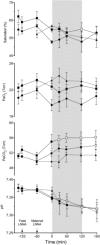
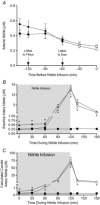
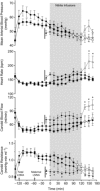

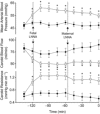
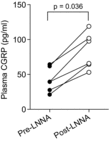
Similar articles
-
Perinatal regulation of the cerebral circulation: role of nitric oxide and prostaglandins.Pediatr Res. 1997 Sep;42(3):299-304. doi: 10.1203/00006450-199709000-00009. Pediatr Res. 1997. PMID: 9284269
-
Vasodilator tone in the llama fetus: the role of nitric oxide during normoxemia and hypoxemia.Am J Physiol Regul Integr Comp Physiol. 2005 Sep;289(3):R776-83. doi: 10.1152/ajpregu.00071.2005. Epub 2005 May 19. Am J Physiol Regul Integr Comp Physiol. 2005. PMID: 15905225
-
The neural and vascular effects of killed Su-Streptococcus pyogenes (OK-432) in preterm fetal sheep.Am J Physiol Regul Integr Comp Physiol. 2010 Aug;299(2):R664-72. doi: 10.1152/ajpregu.00116.2010. Epub 2010 May 19. Am J Physiol Regul Integr Comp Physiol. 2010. PMID: 20484698 Free PMC article.
-
Efficacy of carotid collateral perfusion in anaesthetized sheep fetuses.Placenta. 2000 Sep;21(7):718-25. doi: 10.1053/plac.2000.0565. Placenta. 2000. PMID: 10985976
-
Control of the pulmonary circulation in the fetus and during the transitional period to air breathing.Eur J Obstet Gynecol Reprod Biol. 1999 Jun;84(2):127-32. doi: 10.1016/s0301-2115(98)00321-2. Eur J Obstet Gynecol Reprod Biol. 1999. PMID: 10428335 Review.
Cited by
-
The role of gasotransmitters in neonatal physiology.Nitric Oxide. 2020 Feb 1;95:29-44. doi: 10.1016/j.niox.2019.12.002. Epub 2019 Dec 20. Nitric Oxide. 2020. PMID: 31870965 Free PMC article. Review.
-
Nitrite potentiates the vasodilatory signaling of S-nitrosothiols.Nitric Oxide. 2018 May 1;75:60-69. doi: 10.1016/j.niox.2018.01.011. Epub 2018 Feb 8. Nitric Oxide. 2018. PMID: 29428841 Free PMC article.
-
A stereotaxic, population-averaged T1w ovine brain atlas including cerebral morphology and tissue volumes.Front Neuroanat. 2015 Jun 4;9:69. doi: 10.3389/fnana.2015.00069. eCollection 2015. Front Neuroanat. 2015. PMID: 26089780 Free PMC article.
-
Sex-specific associations between cerebrovascular blood pressure autoregulation and cardiopulmonary injury in neonatal encephalopathy and therapeutic hypothermia.Pediatr Res. 2017 May;81(5):759-766. doi: 10.1038/pr.2017.23. Epub 2017 Jan 31. Pediatr Res. 2017. PMID: 28141793 Free PMC article.
-
A physiologically relevant role for NO stored in vascular smooth muscle cells: A novel theory of vascular NO signaling.Redox Biol. 2022 Jul;53:102327. doi: 10.1016/j.redox.2022.102327. Epub 2022 May 9. Redox Biol. 2022. PMID: 35605454 Free PMC article. Review.
References
-
- Blood AB, Power GG. In vitro and in vivo kinetic handling of nitrite in blood: effects of varying hemoglobin oxygen saturation. Am J Physiol Heart Circ Physiol. 2007;293:H1508–H1517. - PubMed
-
- Buhimschi C, Buhimschi I, Yallampalli C, Chwalisz K, Garfield RE. Contrasting effects of diethylenetriamine–nitric oxide, a spontaneously releasing nitric oxide donor, on pregnant rat uterine contractility in vitro versus in vivo. Am J Obst Gynecol. 1997;177:690–701. - PubMed
Publication types
MeSH terms
Substances
Grants and funding
LinkOut - more resources
Full Text Sources
Other Literature Sources

